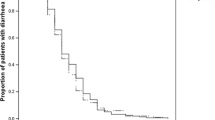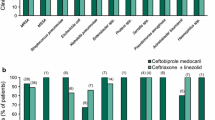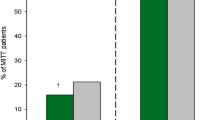Abstract
The seizure-inducing potential of carbapenems has been debated since the introduction of imipenem/cilastatin over 20 years ago. Doripenem is a new carbapenem, recently approved in the US for the treatment of adults with complicated urinary tract infections (cUTI) or complicated intra-abdominal infections (cIAI), and additionally in the EU for nosocomial pneumonia, including ventilator-associated pneumonia. Here, the seizure-inducing potential of doripenem is evaluated, using data from in vitro and in vivo animal studies, doripenem clinical trials and doripenem postmarketing reports of seizures. Animal studies indicate that doripenem has low binding affinity for GABA receptors and does not induce seizures at doses greater than seizureinducing doses of imipenem or meropenem. In clinical studies of cUTI or cIAI, no seizures were reported in the 1332 patients treated with doripenem (500-mg infusion every 8 hours). In two studies, patients with nosocomial pneumonia were treated with doripenem 500 mg (1-or 4-hour infusion every 8 hours), and the incidence of seizures was lower for doripenem (1.2% [6/485]) than imipenem (3.8% [10/263]) or piperacillin/tazobactam (2.7% [6/221]). For patients with seizure-predisposing conditions, seizures occurred during treatment for 3/193 (1.5%) in doripenem, 1/66 (1.5%) in piperacillin/ tazobactam and 6/116 (5.2%) in the imipenem group. The review of data from both clinical trials and postmarketing surveillance supports the low seizureinducing potential of doripenem. The seizure potential of doripenem should be evaluated further in patients at increased risk for seizure.



Similar content being viewed by others
References
Schliamser SE, Cars O, Norrby SR. Neurotoxicity of betalactam antibiotics: predisposing factors and pathogenesis. J Antimicrob Chemother 1991 Apr; 27(4): 405–25
Wallace KL. Antibiotic-induced convulsions. Crit Care Clin 1997 Oct; 13(4): 741–62
Primaxin IV (imipenem and cilastin for injection) [package insert]. Whitehouse Station (NJ): Merck & Co. Inc., 2005
Alvan G, Nord CE. Adverse effects of monobactams and carbapenems. Drug Saf 1995 May; 12(5): 305–13
Rodloff AC, Goldstein EJ, Torres A. Two decades of imipenem therapy. J Antimicrob Chemother 2006 Nov; 58(5): 916–29
Norrby SR. Neurotoxicity of carbapenem antibiotics: consequences for their use in bacterial meningitis. J Antimicrob Chemother 2000 Jan; 45(1): 5–7
O’Donovan CA, White ML, Cheung A, et al. Seizure incidence with imipenem use at a VA hospital. Hosp Formul 1995 Mar; 30: 172–5
Townsend KA, Alaniz C, Stumpf JL, et al. Imipenemcilastatin use: evaluation of dosing and survey of adverse effects. Hosp Pharm 1992; 27: 298, 303–5, 8–10
Wong VK, Wright Jr HT, Ross LA, et al. Imipenem/ cilastatin treatment of bacterial meningitis in children. Pediatr Infect Dis J 1991 Feb; 10(2): 122–5
Pestotnik SL, Classen DC, Evans RS, et al. Prospective surveillance of imipenem/cilastatin use and associated seizures using a hospital information system. Ann Pharmacother 1993 Apr; 27(4): 497–501
Hoffman J, Trimble J, Brophy GM. Safety of imipenem/ cilastatin in neurocritical care patients. Neurocrit Care 2009; 10 3: 403–7
Merrem IV (meropenem for injection) [package insert]. Wilmington (DE): AstraZeneca Pharmaceuticals, 2005
Norrby SR, Gildon KM. Safety profile of meropenem: a review of nearly 5,000 patients treated with meropenem. Scand J Infect Dis 1999; 31(1): 3–10
Linden P. Safety profile of meropenem: an updated review of over 6,000 patients treated with meropenem. Drug Saf 2007; 30(8): 657–68
Norrby SR. Carbapenems in serious infections: a riskbenefit assessment. Drug Saf 2000 Mar; 22(3): 191–4
Invanz (ertapenem for injection) [package insert]. Whitehouse Station (NJ): Merck & Co. Inc., 2006
Teppler H, Gesser RM, Friedland IR, et al. Safety and tolerability of ertapenem. J Antimicrob Chemother 2004 Jun; 53 Suppl. 2: ii75–81 716
Shah PM, Isaacs RD. Ertapenem: the first of a new group of carbapenems. J Antimicrob Chemother 2003 Oct; 52(4): 538–42
Doribax (doripenem for injection) [package insert]. Raritan (NJ): Ortho-McNeil Pharmaceutical Inc., 2008
Ge Y, Wikler MA, Sahm DF, et al. In vitro antimicrobial activity of doripenem, a new carbapenem. Antimicrob Agents Chemother 2004 Apr; 48(4): 1384–96
Jones RN, Stilwell MG, Sader HS, et al. Uniformly enhance activity of doripenem compared to other carbapenems (imipenem, meropenem) when testing P. aeruginosa isolates: results from three continents. Int J Infect Dis 2006; 10 Suppl. 1: S127–8
Horiuchi M, Kimura M, Tokumura M, et al. Absence of convulsive liability of doripenem, a new carbapenem antibiotic, in comparison with beta-lactam antibiotics. Toxicology 2006 May 1; 222(1-2): 114–24
Nakajima Y, Mizobuchi M, Nakamura M, et al. Mechanism of the drug interaction between valproic acid and carbapenem antibiotics in monkeys and rats. Drug Metab Dispos 2004 Dec; 32(12): 1383–91
Doribax [package insert]. Raritan (NJ): Ortho-McNeilJanssen Pharmaceuticals Inc., 2007
Lucasti C, Jasovich A, Umeh O, et al. Efficacy and tolerability of IV doripenem versus meropenem in adults with complicated intra-abdominal infection: a phase III, prospective, multicenter, randomized, double-blind, noninferiority study. Clin Ther 2008 May; 30(5): 868–83
Rea-Neto A, Niederman M, Lobo SM, et al. Efficacy and safety of doripenem versus piperacillin/tazobactam in nosocomial pneumonia: a randomized, open-label, multicenter study. Curr Med Res Opin 2008 Jul; 24(7): 2113–26
Chastre J, Wunderink R, Prokocimer P, et al. Efficacy and safety of intravenous infusion of doripenem versus imipenem in ventilator-associated pneumonia: a multicenter, randomized study. Crit Care Med 2008 Apr; 36(4): 1089–96
Johnson & Johnson Pharmaceutical Research & Development LLC. Cumulative post-marketing review of seizures associated with the use of DORIBAX/FINNIBAX. (doripenem) 27 June 2008; EDMS PSDB-8580935. Raritan (NJ); Johnson & Johnson Pharmaceutical Research & Development LLC., 2008
Keam SJ. Doripenem: a review of its use in the treatment of bacterial infections. Drugs 2008; 68(14): 2021–57
Calandra G, Lydick E, Carrigan J, et al. Factors predisposing to seizures in seriously ill infected patients receiving antibiotics: experience with imipenem/cilastatin. Am J Med 1988 May; 84(5): 911–8
Zhanel GG, Wiebe R, Dilay L, et al. Comparative review of the carbapenems. Drugs 2007; 67(7): 1027–52
Nicolau DP. Carbapenems: a potent class of antibiotics. Expert Opin Pharmacother 2008 Jan; 9(1): 23–37
Acknowledgements Johnson & Johnson Pharmaceutical Research & Development, LLC, provided funding for the design and conduct of the doripenem clinical studies discussed in the manuscript, including collection, management, and analysis of the data. Drs Ketter, Redman and Friedland are full-time employees of the company. Dr Zhanel has received grants from Abbott, Astellas Pharmaceuticals, Bayer, Merck, Ortho-McNeil, Wyeth, Targanta Therapeutics, Affinium Pharmaceuticals and Pfizer. Dr Rubinstein has no conflicts of interest that are directly relevant to the content of this manuscript. Diane Hedrich, MEd, and Bradford Challis, PhD, of Johnson & Johnson Pharmaceutical Research and Development, L.L.C., provided writing and editorial assistance during preparation of the manuscript. The doripenem clinical phase III studies are registered at http://www.ClinicalTrials.gov (DORI-05: NCT00229021; DORI-06: NCT00210990; DORI-07: NCT00210938; DORI-08: NCT00229060; DORI-09: NCT00211003; DORI 10: NCT00211016). Some of the data contained in this manuscript were presented at the 46th Interscience Conference on Antimicrobial Agents and Chemotherapy, 27–30 September 2006, San Francisco, CA; 47th Interscience Conference on Antimicrobial Agents and Chemotherapy, 17–20 September 2007, Chicago, IL; and 48th Annual ICAAC/IDSA 46th Annual Meeting, 25–28 October 2008, Washington, DC.
Author information
Authors and Affiliations
Corresponding author
Rights and permissions
About this article
Cite this article
Zhanel, G.G., Ketter, N., Rubinstein, E. et al. Overview of Seizure-Inducing Potential of Doripenem. Drug-Safety 32, 709–716 (2009). https://doi.org/10.2165/00002018-200932090-00001
Published:
Issue Date:
DOI: https://doi.org/10.2165/00002018-200932090-00001




